Article Index
Power supplies for sensitive analog front-end electronics is a delicate point that requires significant attention in large scale systems. Power supplies must be used in a fashion compatible to the defined grounding scheme (the configuration of power supplies is strongly linked to general grounding). Analog front-end electronics is in many cases extremely sensitive to noise in the power supply because of the single ended nature of detector signals.
The question of location of the power supply units and the related transfer of power on cables often have significant problems. Low frequency voltage drops on cables can to a large degree be compensated for by the use of remote sensing to compensate for cable losses. Remote sense can on the other hand also pose stability problems as the compensation loop must be stable under large load variations and with different cable characteristics. In special cases the remote sense circuit must be specially adapted to the final working conditions. High frequency components can only be handled with the use of local decoupling capacitors.
In most cases a difficult choice must be made between using normal commercial power supplies in the counting room with long cables (~80m) to the front-end electronics in the detector, or having power supplies in the cavern close to the experiment but then having to deal with radiation and magnetic fields. Power supplies for the use in the cavern must be specially designed to handle the radiation effects and the magnetic fields. For the general LHC experiments only few companies are being considered to be capable of supplying power supplies that can handle the environments of the experimental caverns. The Silicon Tracker colaboration has decided to use the MARATON power supplies from Wiener which will located in the cavern.
A special set of radiation tolerant linear regulators have been developed for the LHC experiments. The Silicon Tracker uses intensively the L4913 regulators for power regulation and distribution in the Service Boxes.
For the sensors bias voltage (we call it high voltage although it can not be considered as such since it goes only up to 500V), a standard (non radiation resistant) solution from CAEN has been adopted. These systems are widely used in high energy physics and have proven to be very reliable.
Hardware and software for the integration of the HV and LV in the LHCb ECS system will be available.
A set of general points to be aware of in the design of the power distribution and grounding and shielding scheme are:
-
Prevent ground loops via power supplies when ever possible.
-
Use floating low voltage power supplies.
-
Use twisted power cables to minimize noise pickup/generation.
-
Use remote sense to compensate for voltage drops on cables.
-
Remote sense must be fully differential to minimize noise pick up.
-
Remote sense must be capable of compensation for voltage drop in power supply return (known problem with radiation tolerant linear regulators from ST).
-
Take special care of high voltage and its distribution.
-
No single point failure must generate safety hazards (e.g. high voltage connected to accessible structure).
-
Separate if possible power supplies for analog front-end from power supplies for digital logic.
-
Sudden power consumption drop may generate serious over-voltage on load. Extensive local decoupling and over voltage protection may be needed.
-
Magnetic coils/transformers and cooling fans in power supplies are sensitive to magnetic fields.
-
Power supplies are known to be sensitive to single event burn-out caused by hadrons.
-
Switching mode power supplies are known to in some cases to generate significant common mode noise.
-
...
The following figure shows and simplified alltoghether scheme with the LV power supply lines, HV and grounding for the Silicon Tracker. The scheme is more intended for the the Inner Tracker detector, but it can be easily extended for the Trigger Tracker.
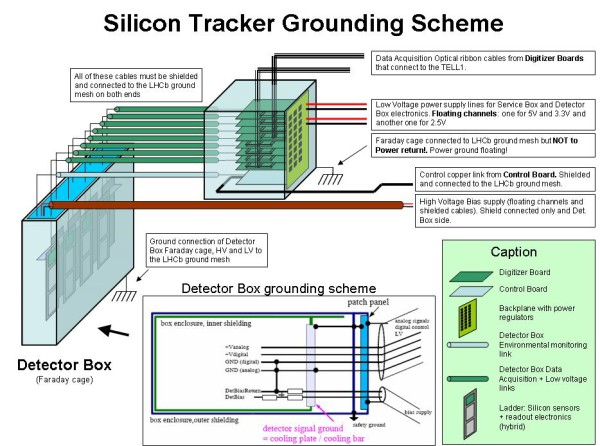
LOW VOLTAGE-MARATON
The power supply system is kept completely floating, only in the detector box the main grounding point will be connected to the general LHCb ground.
Both for the digital and analog power of the hybrid 2.5 V are needed. Two separate radiation hard regulators, type L4913 are located on the backplane of the service box and will provide the voltages. Sense lines for both the voltage and ground lines are used.
Analog and digital ground are connected together on the backplane of the service box, but they are kept floating and not connected to safety ground at this point. Although both grounds are in principle kept separate on the cable as well as on the hybrid layout, they are again connected together on the hybrid at one point to avoid problems due to different voltage drops on the two ground lines.
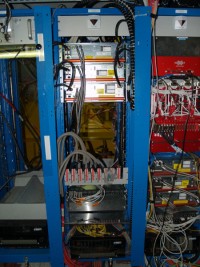
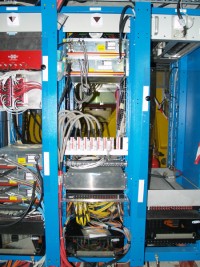
The regulators are supplied by a MARATON system (Magnet field- and Radiation Tolerant New Power Supply System), which is a low noise and low ripple modular power supply system developed for being located in hostile (radiation and magnetic field) environments.
As shown in the figure it consists of three separate parts:
-
Power modules, located in the cavern, which are supplied by a high DC voltage, which they convert into the nominal voltages needed by the service boxes.
-
The AD/DC + APFC board, located in the counting house, which provide the DC supply for the power modules and the Active Power Factor Correction (for EMC issue).
-
The Control + auxiliary power supply board, located in the counting house, also used for monitoring.
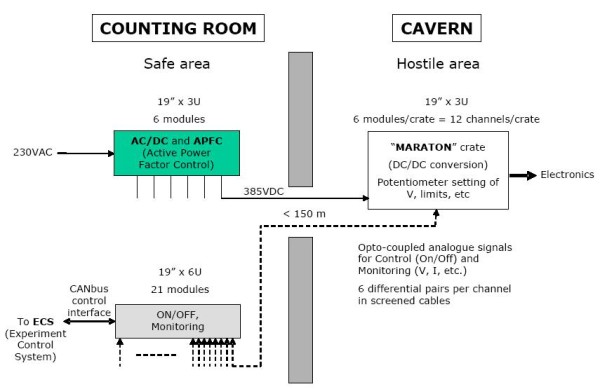
AC/DC+APFC and control boards are not tolerant to radiation and magnetic field, so they are located in the safe area of the counting house. For this reason, the settings of the modules output Voltage, Current Limit and the maximum module voltage is done by manually trimming of a potentiomer in the power modules. Limited remote control will be available for ON/OFF channel switching and for monitoring some relevant status signals. A 72-line shielded cable is needed between each MARATON crate (containing 6 power modules) and each control board for 36 differential signals.
Power modules are located in hostile area, and have two floating channels each, with a channel to channel resistance greater than 10 kOhm, and a possible maximum channel to channel voltage of 100 V. These power modules are water cooled (air cooling is not possible since fans do not work properly in magnetic field environments) and all their inductive elements are completely shielded. Available modules that can be used and are of our interest are: 2-7V @ 40A (2x250W) and 5-15V @ 20A (2x300W).
According to the IT and TT power requirements[1][2] and following the MARATON architecture, the layout shown in the figure will be used.
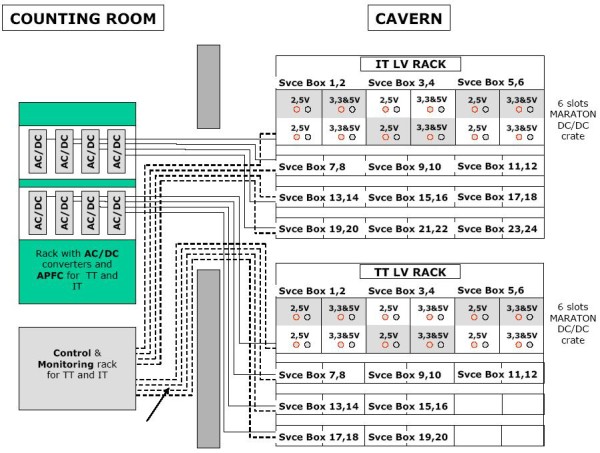
For the IT the requirements are, on one hand, 12 double channel modules of 2-7V, which will supply the 2.5V electronics (hybrids and service box components). On the other hand, 12 double channel 5-15V modules will supply the 5V and 3.3V electronics in the service box. At the output of the 2-7V modules we would need about 5.5V, since we are supposing a dropout voltage of 2.5V in the regulators and a back and forth drop voltage about 0.5V in the cables (length about 20 m) that goes from the MARATON power crates to the service boxes. Using the same reasoning, at the output of the 5-15V modules we would need about 8V. The number of MARATON crates needed for the IT is 4, which implies that 4 AC/DC + APFC boards and 4 Control and Monitoring boards are also needed.
For the TT the requirements are quite similar. The number of power modules needed for each type is 10, and the output voltage of the power modules should be set to a higher value (near 1V), since the drop voltage in the cables will be higher due to the greater current consumption of TT service boxes.
HIGH VOLTAGE - CAEN
The bias voltage in the Silicon Tracker detector is based on a standard (non radiation resistant) CAEN solution. These systems are widely used in high energy physics and have proven to be very reliable. Hard- and software for the integration in the LHCb ECS system will be available.
The layout for IT subdetector can be seen below. We plan to supply the 336 ladders of IT with one SY1527 high voltage crate with 8 A1511B modules. Each module provides 12 floating channels up to 500V and 10mA each. Studies on radiation damage for IT ladders shows that after 10 years of LHCb their bias current consumption will be below 2mA per ladder. In order to reduce costs, four detector ladders will be connected to one supply channel. This will be done on a special HV patch panel in the counting room. This connection of several ladders to one supply channel generates grounding loops, which are however separated by the high impedance line filtering on the hybrids (see Figure 1) and should thus not impose any problem.
The grouping of four ladders into one bias voltage channel is done according to the same granularity as the eight fold data readout granularity, which was optimised according to the expected occupancy. One readout section corresponds therefore to two bias voltage supply sections.
After the HV patch panel in the counting house 12 multi-wire cable will pass through the wall, one per IT box. In the cavern, a second HV patch panel will split this 56-wires (28 channels) cable into 4 14-wires (7 channels) cables, one per layer.
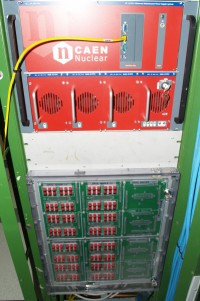

For the TT subdetector, the case is different as the radiation and thus the expected bias currents are higher. Here we plan to supply the central ladders individually since the radiation damage they suffer is quite high, and the external ones will share the HV channel as in the IT. Therefore a special HV patch panel located in the couting room will be also built for the TT. One SY1527 crate with 13 A1511B modules will be used. 6 cables of 24-wires will feed each detector quadrant. A pseudo HV patch panel (connector to connector) is foreseen in the cavern to separate the moveable part of cable (20m) from the fixed one (80 m).
In both IT and TT the shield of cables will be connected to the main ground of the experiment. In order to allow a possible HV upgrade all modules are wired up to the counting house.





